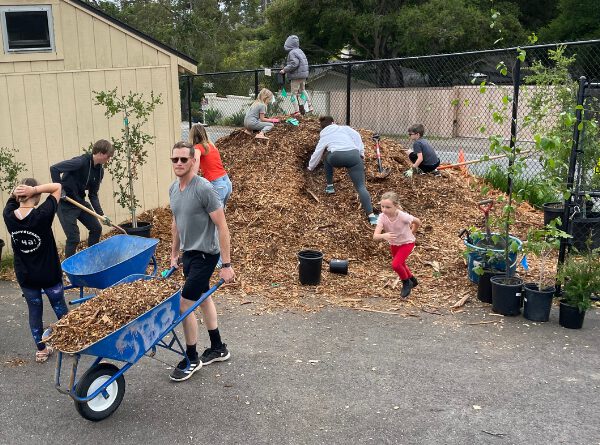On a Saturday morning, you can find a circle of students huddled around a newly planted oak sapling, their hands still dusty from digging. Nearby, parents and teachers talk and laugh over piles of mulch as they transform a forgotten corner of the campus into a thriving outdoor classroom where learning, play, and environmental stewardship grow side by side. This isn’t just a school beautification, it’s a growing movement.
The Santa Barbara Education Foundation is proud to serve as a fiscal sponsor for Campus Canopy, a program that’s reimagining what schoolyards can be: places where students learn under the shade of trees and surrounded by native plants.
What began as a grassroots effort by local moms, Sarah Sheshunoff, Brook Eiler, and Devon Azzam, has grown into a program to green school campuses across Santa Barbara. Inspired by a shared belief in the power of nature to shape how children learn and grow, the founders combined their expertise in landscape architecture, education, and nonprofit leadership to create joyful, collaborative planting days that build community and climate resilience from the ground up.
“These are the projects we always wanted to work on— but not in the formal landscape architecture sense,” said Brook Eiler, co-founder of Campus Canopy. “By bringing design expertise and tapping into financial resources, we’re able to accelerate school beautification and tend these campus spaces in a more meaningful, joyful, and lasting way.”
Campus Canopy projects are rooted in ecological restoration, student engagement, and a design approach that starts with the natural potential of each site. Since its inception, the program has worked with four local schools, planted over 400 plants and 100 trees, and inspired dozens of students and their families to roll up their sleeves and get involved.
At San Marcos High School, students in the Sustainability Club recently helped restore a drainage ditch with native plants, while a new native perimeter hedge will soon provide shade, habitat, and a low-cost alternative to fencing. At Harding University Partnership School, a previously overlooked patch of campus is being transformed into a year-round native habitat filled with wildflowers and young oak trees. A research study of Harding’s outdoor classroom found that naturalized spaces led to increased social-emotional play, enhanced literacy development, and deeper connections with nature.
What sets Campus Canopy apart is its focus on greening the everyday spaces where students spend most of their time, often areas with little to no tree cover. The program aims to increase native plantings and shade canopy to cover at least 30% of each campus. Its long-term commitment includes climate-smart, regenerative designs and collaborative maintenance plans that engage students, families, and school staff every step of the way.
“In three hours, we had planted 100 baby plants and mulched the entire area—now it’s thriving,” shared Veronica Binkley, Principal at Harding University Partnership School.
In an era of rising climate anxiety and youth mental health concerns, access to green spaces is more important than ever. Campus Canopy offers students the opportunity to learn, connect, and engage in environments that promote well-being, spark curiosity, and build resilience for the future.
Community members can support Campus Canopy by volunteering for an upcoming school planting day this fall or making a tax-deductible gift to help expand the program’s reach. To learn more or get involved, contact the Santa Barbara Education Foundation or visit www.santabarbaraeducation.org.
Founded in 1985, the Santa Barbara Education Foundation promotes private support for Santa Barbara’s public education system, serving nearly 12,000 students across 21 schools.


Leave a Response